 How financially savvy and responsible are your children? How good is their Money IQ?
How financially savvy and responsible are your children? How good is their Money IQ?
Do they understand ATM machines and credit cards don’t actually offer an unlimited supply of money?
Are the words debt, budget, interest, income, and savings like a foreign language to them?
Sadly, according to one article they probably don’t. Researchers found that “73% of American consumers die in debt.” Most of that is credit card debt. People today are controlled by the requirement to pay off debt.
As parents, we have the chance to ensure that our children know how to responsibly control their money instead of living their lives in debt being controlled by money.
We need to be intentional about teaching children financial responsibility. As Christine M. Field says in her book Life Skills for Kids, “Children need to be given the opportunity to make financial decisions as early as possible. It is better to let them learn, experiment, and make mistakes with small sums than to wait…”
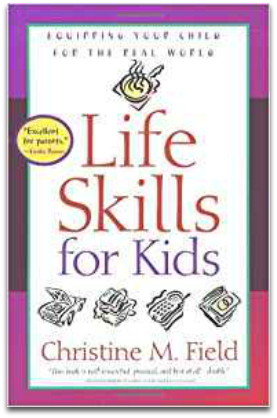 I have been blessed to be able to stay home and homeschool my daughters, but I am only able to do that because my husband and I have made it a priority to manage money responsibly. It has made such a difference in our lives we decided it is important to instill financial lessons in our own daughters.
I have been blessed to be able to stay home and homeschool my daughters, but I am only able to do that because my husband and I have made it a priority to manage money responsibly. It has made such a difference in our lives we decided it is important to instill financial lessons in our own daughters.
I am definitely still learning on this parenting journey (my daughters are 11 and 10); however, there are a few crucial financial tips that I have discovered over the years.
Parents Must Lead by Example
As Rachel Cruze repeatedly states in the book, Smart Money Smart Kids, which she wrote with her father, Dave Ramsey, “more is caught than taught.”
Children see what you are doing and will imitate your behavior. If you are struggling with finances yourself, there are many books and programs that can help you overhaul your finances. And as you learn to take control of your own finances, making decisions and designing budgets, your children will learn how to take control of their own money.
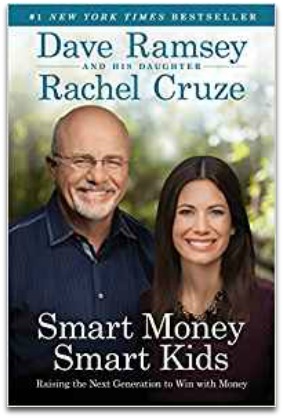 Dave Ramsey adds, “I was that dad who realized that to financially change my family tree, I had to intentionally raise money-smart kids…You get to decide today, from this day forward, you are going to be intentional about not only your money but also in teaching the next generation.”
Dave Ramsey adds, “I was that dad who realized that to financially change my family tree, I had to intentionally raise money-smart kids…You get to decide today, from this day forward, you are going to be intentional about not only your money but also in teaching the next generation.”
My daughters have grown up watching my husband and I budget, comparison shop, research, save our money to pay cash for large purchases such as vehicles, and be intentional about our finances. As a result, they have witnessed firsthand how we responsibly handle our money.
Have Money Conversations
Too many people feel reluctant to talk about money. How much they have and what they spend it on are almost taboo subjects in many households. But money should not be a taboo subject!
If you have made financial mistakes, let your (older) kids know. Be candid about your bad financial choices. Tell them the stupid reasons why you made them (perhaps all your friends were doing it) and how long it took you to recover from them (maybe you are still trying to recover years later!).
Not only can you show them that you have learned from your mistakes, but they may benefit from seeing the consequences your mistakes had on you. Hopefully, they will decide to not follow the same path of mistakes.
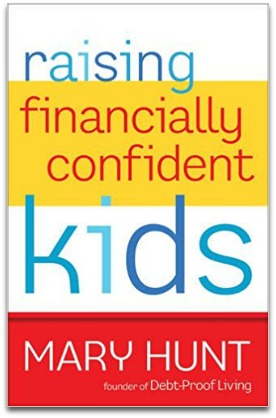 In life, we are given many choices, especially on things to buy. How we talk about these purchasing choices can help children learn how to make financially smart choices. Especially when it comes to NOT buying a product.
In life, we are given many choices, especially on things to buy. How we talk about these purchasing choices can help children learn how to make financially smart choices. Especially when it comes to NOT buying a product.
In Raising Financially Confident Kids, Mary Hunt suggests saying “We don’t choose to spend our money that way” instead of saying “We can’t afford it.”
It’s all about choice!
Don’t Give Out of Guilt
It’s not fair to the parent or the child if the child is constantly receiving gifts out of guilt. One article found on Psychology Today states “too many gifts can turn little darlings into ungrateful bullies who are never satisfied.” The article lists further negative results of excessive gift giving. Instead of spending money on objects, they recommend spending quality time together.
Start Early
Young children can be taught basic money principles. Even preschoolers can help stack change in piles, create a “bank,” help shop for donations, play store, and more. Teaching children at a young age helps instill responsible habits they can use for the rest of their lives.
Below are some activities I have done with my own children to teach them financial independence.
Younger Kids
Discuss Wants vs Needs
You can create a collage that shows the difference between wants and needs. My daughters know they need clothes, but they certainly don’t need the $75 pair of pants. They need food, but they don’t need it from a restaurant. This is a beneficial trait to help prioritize financial purchases. It’s okay to buy the wanted items, as long as all of the needed items have been covered.
Play Store
We have had fun finding and pricing random objects throughout our house. Then, we each get a set amount of money to “buy” items. Young ones learn rather quickly that they can’t buy everything with the small amount of money they have. This is also a great math lesson for those learning how to count change.
Create a “Bank”
My daughters and I enjoyed making their “banks” together. Each bank consisted of four square plastic containers with lids that I purchased and hot glued together. My daughters decorated the containers and labeled them: Donate, Spend, Save, and Invest.
We discussed what donate (give to others), spend (buy items), save (short term and long term), and invest (long term) meant, although they didn’t add anything to the invest container initially.
As my daughters received money, they divided the money into the separate containers. I had also created a sheet of paper similar to a checkbook ledger, which they updated (with my help at first) as they deposited or withdrew money from their containers.
This allowed them to easily see how much they had within each container, and it was great practice for balancing an actual checkbook. Every once in a while, we would take the money out of each container to count and make sure their total balance equaled what was written on the sheet.
Give Intentionally
Each month, we pick a “charity of the month” to donate to. We have used Charity Navigator to check the ratings of charities. Not only is this an activity a family can do together, but it also teaches young kids about generosity and needs in the community around them.
Each Sunday, I have my daughters count a certain amount of change from our “change jar” to put into a “hungry jar” we decorated. After a while, we count up the money in the hungry jar and go shopping together to purchase food for the local food shelf. This is a wonderful learning experience in itself because my daughters have to budget accordingly to purchase needed items using the amount they have.
Since my daughters have grown up seeing us donating to church or various charities, they realize the necessity of giving to others, too. They have each donated to some charities on their own.
Plan Inexpensive Activities
Have fun planning inexpensive activities together. My family enjoys visiting the park, fishing, going to the library, attending free programs and activities, reading, doing puzzles together, playing games, watching movies at home, and many more inexpensive activities. This shows that you don’t need to spend a lot to still have fun. You can discuss each option and the opportunity cost of your choices.
Read Books About Money
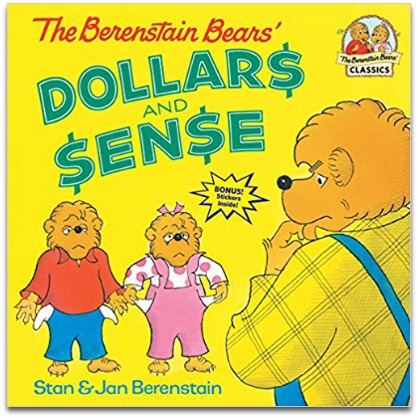 Your library has loads of books you can check out for kids about money. One book my daughters have is The Berenstain Bears’ Dollar$ and $en$e, which includes checks in the back of the book for children to use.
Your library has loads of books you can check out for kids about money. One book my daughters have is The Berenstain Bears’ Dollar$ and $en$e, which includes checks in the back of the book for children to use.
Reading a story about how some of their favorite characters have worked to save or spend or made financial mistakes does three things. First, it reinforces what you have already told them about your own youthful errors.
Second, it gives them a chance to envision themselves making those same choices and experiencing what the consequences feel like.
Third, and most importantly, it gives you another invitation to talk to them about the choices of those characters. You can ask them what they did that worked, what better choices they could have made, and what your child would have done in that character’s shoes.
Have Them Shop on a Budget
In the summertime, my daughters and I often go to rummage sales. I will typically give them each $1-$2 and let them use that money to buy whatever they would like (within reason). Not only does this help them to budget, but they have also practiced negotiating skills to ask for lower prices.
Explain Credit Cards
According to an article found on The Balance, “The average credit card debt per U.S. household was $8,117 in November 2017”. Children need to understand that a credit card is not free money. Anyone who uses a credit card is responsible for paying for the full amount when the bill arrives otherwise there will be a penalty and extra charges.
You can compare credit cards to checking books out from a library. Just like a credit card bill has a due date, library books also have a due date. If the supplies are not turned in on time, there is a fee. If you don’t pay the full amount of a credit card on time, you will be paying a lot more for items than you should.
Older Kids
Open a Savings Account
When each of my daughters turned 10, they emptied their “savings” container and opened their own savings accounts at a local bank. This has kept them engaged as they learn how to save while having fun watching their savings account balance grow.
Explain Interest
With a savings account comes the excitement of earning a little bit of interest. This is a great opportunity to teach about interest.
If they were to borrow money (for example, by not paying off a credit card bill in full), they would be paying interest. It’s important to understand that the interest on a credit card bill or loans can add up to be significantly more than the original price of the item they purchased. As a result, interest can be viewed positively or negatively.
Open a Checking Account
My daughters haven’t opened their own checking accounts yet, but we do intend on having them open one before they graduate high school. Children should learn how to properly manage a checking account, write checks, and balance a checkbook before they move out on their own. Young adults have enough to worry about when they are just starting out and having this skill will help them financially.
Plan a Vacation Together
Planning a vacation (or other event) is a perfect and fun way to teach your child how to use a budget! Set a dollar amount and then, using a budget, plan the various activities for a fun family vacation. Try to think of all of the expenses and create an itemized list. Then after the vacation, see how well you did on your budget. Budgeting doesn’t have to be all doom and gloom!
Talk About Saving vs Investing
When my daughters initially created their “banks” they didn’t use the invest container right away. As they got older, however, they decided to add money to their investing containers to start their own little business.
As they continue to get older, we hope to expand the conversation more on investing with mutual funds and stocks. As practice, we can pick a stock from Wall Street and pretend to buy it. We can follow it for a month or two and then see how much we would have made or lost.
Give an Allowance/Commission
This one is often debated. Many parents feel that children should not receive an allowance just for being a part of the family. Instead of allowances, Tracie from Penny Pinchin Mom gives commission, bonuses, and fines to her children, which they discuss once a week on “pay day.”
Instead of an allowance or commission, some families may choose to give a set amount of money to their children for certain items such as clothes. This forces children to shop around, look for sales, and budget wisely unless they want to pay for the items themselves.
Discuss Entrepreneurship/Job Opportunities
 My daughters don’t earn an allowance or a commission, so they only had money they had received as gifts. Since they wanted to have more money, they created their own little business selling various crafts they have made such as coasters, pillows, jewelry, potholders, magnets, and more.
My daughters don’t earn an allowance or a commission, so they only had money they had received as gifts. Since they wanted to have more money, they created their own little business selling various crafts they have made such as coasters, pillows, jewelry, potholders, magnets, and more.
They have learned a lot through this process such as expenses, income, profit, prices, competition, and much more.
Not only did we read multiple books together about entrepreneurship for kids, but they also watched all of the videos from Secret Millionaire’s Club, which has many short educational cartoons for kid entrepreneurs.
Even if your children aren’t the entrepreneurial type, they can develop an understanding of the correlation between work and money through earning chore money or by doing a job search together to find jobs they could do to earn money.
Create a Financial Goal
Is your son craving the latest X-Box game? Does your daughter want archery lessons? Make it their financial goal and help them to develop a plan to achieve it.
Whatever financial goal your children create (an amount to donate, an amount to save by a certain date, a purchase of an item), have them write it down and display it. Then when they make routine spending decisions they have their goal front and center to remind them of their larger plans. You will be surprised at what they decide not to buy so they can pay for their archery lessons or X-Box.
Create a Budget
Many financially successful people run their households with a budget. Budgets have allowed my family to control our spending and achieve our larger savings goals.
One day, your children will move out of the house and they will have to manage their budgets themselves. Their teenage years are the perfect time to practice. You can create a fictitious budget that adds lines such as rent/housing, food, insurance (auto, dental, health, homeowners/renters, identity theft, and life), gas, electric, water, garbage, internet, phone, and more.
Most teens have no idea how expensive it is to run a household! It is very beneficial to show them some of the prices you pay for items such as utilities each month. When they do move out on their own, hopefully they aren’t as shocked by the cost of living and they have practice following a realistic budget. This is also a great time to reiterate wants vs needs.
Most of my daughters’ clothes come from rummage sales, consignment shops, thrift stores, or sales racks. They have noticed and commented that one full-price clothing item costs the same price as multiple items purchased on a discount. This is a great time to discuss opportunity costs. Would they rather have that one item or all of the other clothes they were able to pick out for the same price?
Create a Price Sheet
I created a chart with a list of food items we use on a normal basis in my house along with the names of a few different stores. We searched for the items together at each store, wrote down the prices, and compared them.
This was a great opportunity to teach my daughters about unit pricing, name brand items vs generic items, positioning on shelves, quality vs quantity, and comparison shopping. This was also helpful for me to see if I was really getting the best deals!
Talk About Scams
It is important for your children to understand ways to protect themselves from identity theft such as using strong passwords, shredding documents with their information, and not giving away important information (even if someone calls them and says they need it immediately).
In addition to this, children need to know that even if something says it is “free,” it may not really be free.
Talk About Paying for College
Not every child will go to college or a technical school, but there should at least be some kind of discussion about the financial costs and possible consequences (both positive and negative) of completing a degree.
If your children plan to go to college have a good talk with them about where they want to go and what they want to major in. Then discuss what the average pay is for their desired job and what kind of lifestyle they can expect.
Talk to them about how they intend to pay for their schooling. Discuss the cost difference between a private vs public institution and a technical college vs university. Are they hoping to earn college classes during high school that can be transferred, apply for scholarships or loans, or will you be funding any of their college? Talk about student loan debt and brainstorm ideas together on ways to pay for college.
Read Books About Investing and Entrepreneurship for Kids
 Again, the library is a great resource for numerous money books, whether you want more information on investing, entrepreneurship, savings, or money in general. My daughters have enjoyed numerous books including
Again, the library is a great resource for numerous money books, whether you want more information on investing, entrepreneurship, savings, or money in general. My daughters have enjoyed numerous books including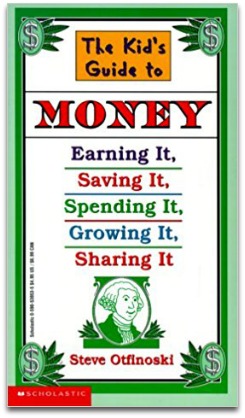 A $mart Girl’s Guide to Money: How to Make It, Save It, and Spend It by Nancy Holyoke and The Kid’s Guide to Money: Earning It, Saving It, Spending It, Growing It, Sharing It by Steve Otfinoski.
A $mart Girl’s Guide to Money: How to Make It, Save It, and Spend It by Nancy Holyoke and The Kid’s Guide to Money: Earning It, Saving It, Spending It, Growing It, Sharing It by Steve Otfinoski.
Take a Financial Course
Some schools offer financial courses as part of their curriculum. Others do not. If your school doesn’t, think about finding an online or independent course on financial responsibility for teens.
My daughters (and I) have completed the Foundations in Personal Finance Middle School Edition for Homeschool, which I highly recommend. We learned many things including whether we were spenders or savers, the different types of economic systems, and the different types of insurances a person should have. When my daughters are older, I intend to have them complete the High School Edition as well.
Of course, these are all suggestions. What may work well for my family may not work well for your family and vice versa. My hope is that this encourages you to be intentional about finances with your children now so that they are financially independent later.
The 2-Minute Action Plan for Fine Parents
Answer this question honestly for yourself: Am I financially responsible? Write down what you are doing well and where you might want to improve.
Write a list of what you would like your children to learn financially by the time they are an adult.
Write a list of what each of your children already knows about money or finances. This could be as simple as knowing the difference between a penny and a quarter. Hopefully, this will give you confidence in knowing that your children aren’t starting from scratch, even if your previous list seems quite long.
The Ongoing Action Plan for Fine Parents
If you honestly answered no to the question “Am I financially responsible,” thank you for your honesty. Now ask yourself: What can I do differently to make that answer an honest yes? As Dave Ramsey often says, “Money is 80% behavior, 20% head knowledge.” You must work to improve your financial life as well as your children’s financial lives. Let them see your intention to improve yourself and their future (even if they may not understand at first).
Remember, parents must lead by example. When you are balancing your checkbook, let your children see how you write a check. When you go shopping, let them help you with your list, compare prices, make returns, count money, etc.
Be open with your children about expenses and budgeting without a negative connotation.
Talk to your children about why it is important for them to have financial freedom.
Refer to your list of what you would like your children to learn financially and be intentional about looking for opportunities to teach your children. Pick one or two you’d like to focus on for the next two or three months. Then think of another one to add for the next three months. Keep adding until you and they have conquered all of them.
Amaiazn
Thanks for sharing more info
This is an amazing post! I learnt a lot of useful information, and planning to use it to have some conversations with my 4-year old on the topic of money and finance.
I included your post in my Sunday Night Reading List recommendation in my blog “Parent Penguin” for this week! https://parentpenguin.wordpress.com/2018/04/01/sunday-night-reading-list-01apr2018/
Thanks for this insightful post!
Thank you very much! I greatly appreciate your feedback and sharing with others. Have a wonderful day!
Peanut tubs may work well. I used containers with square bottoms (to fit together snuggly when I glued them) and lids that could be twisted on and off (to make it easy for my daughters to open and close on their own). They definitely don’t need to be fancy- whatever works to serve the purpose. I would be very interested to see what you are able to come up with! You can e-mail me a picture if you would like.
Oh my goodness Brigitte! You have put so much research into this article… but more importantly into raising your own family financially smart. Not to mention gained so much wisdom from your research!
I haven’t done a Dave Ramsey course yet, but my husband (and other close family) highly highly recommend living by a lot of his principles. (I was just looking at that Life Skills book too for next year.)
I think you have achieved super mom status to me. ; ) You are so disciplined! Human nature is not naturally disciplined.(The eyes of man are never satisfied- Proverbs 27:20.) Women aren’t naturally disciplined. (I swear we have *shopping* in our blood.) Your advice and experience are to be commended! : )
When I told my own homeschool students about the tupperware 4 compartment idea, they were excited. Thanks for the practical idea. And as far as the giving box goes, we just started sponsoring two children in Rwanda to go to school. The program through Africa New Life allows for you to also gift your students with food, goat, solar lamp, sheets, umbrella… etc. So, we were excited to introduce this realistic way of saving chore money and grandpa cash for giving to those who have a LOT LESS than we do. Plus, they are even pen pals now… so it’s totally more than just a check written, it’s a relationship built too. : )
Thank you so much for your kind words. I am glad you were able to learn something from this article. I am definitely still learning a lot as I go! That’s wonderful that you are sponsoring children in Rwanda. Not only does that show compassion to others, but it’s a great geography lesson learning all about Rwanda. That’s amazing that they have even been able to become pen pals. I have pictures of the 4 container jar on my website under the blog section if you were interested in seeing what the “banks” looked like that my daughters and I created together. Have a wonderful day!
Oh, thanks for the jar picture… I was imagining tupperware, but maybe peanut tubs would be more appropriate!
Peanut tubs may work well. I used containers with square bottoms (to fit together snuggly when I glued them) and lids that could be twisted on and off (to make it easy for my daughters to open and close on their own). They definitely don’t need to be fancy- whatever works to serve the purpose. I would be very interested to see what you are able to come up with! You can e-mail me a picture if you would like.
Thank you! I’ll have to look into The Opposite of Worry. Have fun planning and going on your trip together as a family!
Thanks for this article! I’ve just been re-reading The Opposite of Worry, and have decided that this the year for my family to figure out the money stuff – both parents and kids. I’ll check out the books and resources you offer here as well.
Many of the things you mention I do intuitively, like need vs. want, but I’d like to consciously educate both myself and my boys more. Plus, we’re about to go on a trip, and I’ve been thinking about having the five of us plan our spending together…
Thanks again!